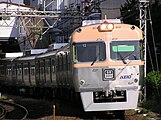Keio Inokashira Line
| Keio Inokashira Line | |||||||||||||||||||||||||||||||||||||||||||||||||||||||||||||||||||||||||||||||||||||||||||||||||||||||||||||||||||||||||||||||||||||||||||||||||||||||||||||||||||||||||||||||||||||||||||||||||||||||||||||||||||||||||||||||||||||||||||||||||||||||||||||||||||||||||||||||
|---|---|---|---|---|---|---|---|---|---|---|---|---|---|---|---|---|---|---|---|---|---|---|---|---|---|---|---|---|---|---|---|---|---|---|---|---|---|---|---|---|---|---|---|---|---|---|---|---|---|---|---|---|---|---|---|---|---|---|---|---|---|---|---|---|---|---|---|---|---|---|---|---|---|---|---|---|---|---|---|---|---|---|---|---|---|---|---|---|---|---|---|---|---|---|---|---|---|---|---|---|---|---|---|---|---|---|---|---|---|---|---|---|---|---|---|---|---|---|---|---|---|---|---|---|---|---|---|---|---|---|---|---|---|---|---|---|---|---|---|---|---|---|---|---|---|---|---|---|---|---|---|---|---|---|---|---|---|---|---|---|---|---|---|---|---|---|---|---|---|---|---|---|---|---|---|---|---|---|---|---|---|---|---|---|---|---|---|---|---|---|---|---|---|---|---|---|---|---|---|---|---|---|---|---|---|---|---|---|---|---|---|---|---|---|---|---|---|---|---|---|---|---|---|---|---|---|---|---|---|---|---|---|---|---|---|---|---|---|---|---|---|---|---|---|---|---|---|---|---|---|---|---|---|---|---|---|---|---|---|---|---|---|---|---|---|---|---|---|---|---|---|
 | |||||||||||||||||||||||||||||||||||||||||||||||||||||||||||||||||||||||||||||||||||||||||||||||||||||||||||||||||||||||||||||||||||||||||||||||||||||||||||||||||||||||||||||||||||||||||||||||||||||||||||||||||||||||||||||||||||||||||||||||||||||||||||||||||||||||||||||||
 Keio 1000 series EMUs on the Inokashira Line in June 2020 | |||||||||||||||||||||||||||||||||||||||||||||||||||||||||||||||||||||||||||||||||||||||||||||||||||||||||||||||||||||||||||||||||||||||||||||||||||||||||||||||||||||||||||||||||||||||||||||||||||||||||||||||||||||||||||||||||||||||||||||||||||||||||||||||||||||||||||||||
| Overview | |||||||||||||||||||||||||||||||||||||||||||||||||||||||||||||||||||||||||||||||||||||||||||||||||||||||||||||||||||||||||||||||||||||||||||||||||||||||||||||||||||||||||||||||||||||||||||||||||||||||||||||||||||||||||||||||||||||||||||||||||||||||||||||||||||||||||||||||
| Owner | Keio Corporation | ||||||||||||||||||||||||||||||||||||||||||||||||||||||||||||||||||||||||||||||||||||||||||||||||||||||||||||||||||||||||||||||||||||||||||||||||||||||||||||||||||||||||||||||||||||||||||||||||||||||||||||||||||||||||||||||||||||||||||||||||||||||||||||||||||||||||||||||
| Locale | Tokyo | ||||||||||||||||||||||||||||||||||||||||||||||||||||||||||||||||||||||||||||||||||||||||||||||||||||||||||||||||||||||||||||||||||||||||||||||||||||||||||||||||||||||||||||||||||||||||||||||||||||||||||||||||||||||||||||||||||||||||||||||||||||||||||||||||||||||||||||||
| Termini | |||||||||||||||||||||||||||||||||||||||||||||||||||||||||||||||||||||||||||||||||||||||||||||||||||||||||||||||||||||||||||||||||||||||||||||||||||||||||||||||||||||||||||||||||||||||||||||||||||||||||||||||||||||||||||||||||||||||||||||||||||||||||||||||||||||||||||||||
| Service | |||||||||||||||||||||||||||||||||||||||||||||||||||||||||||||||||||||||||||||||||||||||||||||||||||||||||||||||||||||||||||||||||||||||||||||||||||||||||||||||||||||||||||||||||||||||||||||||||||||||||||||||||||||||||||||||||||||||||||||||||||||||||||||||||||||||||||||||
| Type | Commuter rail | ||||||||||||||||||||||||||||||||||||||||||||||||||||||||||||||||||||||||||||||||||||||||||||||||||||||||||||||||||||||||||||||||||||||||||||||||||||||||||||||||||||||||||||||||||||||||||||||||||||||||||||||||||||||||||||||||||||||||||||||||||||||||||||||||||||||||||||||
| Rolling stock | Keio 1000 series | ||||||||||||||||||||||||||||||||||||||||||||||||||||||||||||||||||||||||||||||||||||||||||||||||||||||||||||||||||||||||||||||||||||||||||||||||||||||||||||||||||||||||||||||||||||||||||||||||||||||||||||||||||||||||||||||||||||||||||||||||||||||||||||||||||||||||||||||
| Daily ridership | 547,845 (2010)[1] | ||||||||||||||||||||||||||||||||||||||||||||||||||||||||||||||||||||||||||||||||||||||||||||||||||||||||||||||||||||||||||||||||||||||||||||||||||||||||||||||||||||||||||||||||||||||||||||||||||||||||||||||||||||||||||||||||||||||||||||||||||||||||||||||||||||||||||||||
| History | |||||||||||||||||||||||||||||||||||||||||||||||||||||||||||||||||||||||||||||||||||||||||||||||||||||||||||||||||||||||||||||||||||||||||||||||||||||||||||||||||||||||||||||||||||||||||||||||||||||||||||||||||||||||||||||||||||||||||||||||||||||||||||||||||||||||||||||||
| Opened | 1 August 1933 | ||||||||||||||||||||||||||||||||||||||||||||||||||||||||||||||||||||||||||||||||||||||||||||||||||||||||||||||||||||||||||||||||||||||||||||||||||||||||||||||||||||||||||||||||||||||||||||||||||||||||||||||||||||||||||||||||||||||||||||||||||||||||||||||||||||||||||||||
| Last extension | 1 April 1934 | ||||||||||||||||||||||||||||||||||||||||||||||||||||||||||||||||||||||||||||||||||||||||||||||||||||||||||||||||||||||||||||||||||||||||||||||||||||||||||||||||||||||||||||||||||||||||||||||||||||||||||||||||||||||||||||||||||||||||||||||||||||||||||||||||||||||||||||||
| Technical | |||||||||||||||||||||||||||||||||||||||||||||||||||||||||||||||||||||||||||||||||||||||||||||||||||||||||||||||||||||||||||||||||||||||||||||||||||||||||||||||||||||||||||||||||||||||||||||||||||||||||||||||||||||||||||||||||||||||||||||||||||||||||||||||||||||||||||||||
| Line length | 12.7 km (7.9 mi) | ||||||||||||||||||||||||||||||||||||||||||||||||||||||||||||||||||||||||||||||||||||||||||||||||||||||||||||||||||||||||||||||||||||||||||||||||||||||||||||||||||||||||||||||||||||||||||||||||||||||||||||||||||||||||||||||||||||||||||||||||||||||||||||||||||||||||||||||
| Number of tracks | Double-track | ||||||||||||||||||||||||||||||||||||||||||||||||||||||||||||||||||||||||||||||||||||||||||||||||||||||||||||||||||||||||||||||||||||||||||||||||||||||||||||||||||||||||||||||||||||||||||||||||||||||||||||||||||||||||||||||||||||||||||||||||||||||||||||||||||||||||||||||
| Track gauge | 1,067 mm (3 ft 6 in) | ||||||||||||||||||||||||||||||||||||||||||||||||||||||||||||||||||||||||||||||||||||||||||||||||||||||||||||||||||||||||||||||||||||||||||||||||||||||||||||||||||||||||||||||||||||||||||||||||||||||||||||||||||||||||||||||||||||||||||||||||||||||||||||||||||||||||||||||
| Minimum radius | 200 m (660 ft) | ||||||||||||||||||||||||||||||||||||||||||||||||||||||||||||||||||||||||||||||||||||||||||||||||||||||||||||||||||||||||||||||||||||||||||||||||||||||||||||||||||||||||||||||||||||||||||||||||||||||||||||||||||||||||||||||||||||||||||||||||||||||||||||||||||||||||||||||
| Electrification | 1,500 V DC (overhead catenary) | ||||||||||||||||||||||||||||||||||||||||||||||||||||||||||||||||||||||||||||||||||||||||||||||||||||||||||||||||||||||||||||||||||||||||||||||||||||||||||||||||||||||||||||||||||||||||||||||||||||||||||||||||||||||||||||||||||||||||||||||||||||||||||||||||||||||||||||||
| Operating speed | 90 km/h (55 mph) | ||||||||||||||||||||||||||||||||||||||||||||||||||||||||||||||||||||||||||||||||||||||||||||||||||||||||||||||||||||||||||||||||||||||||||||||||||||||||||||||||||||||||||||||||||||||||||||||||||||||||||||||||||||||||||||||||||||||||||||||||||||||||||||||||||||||||||||||
| |||||||||||||||||||||||||||||||||||||||||||||||||||||||||||||||||||||||||||||||||||||||||||||||||||||||||||||||||||||||||||||||||||||||||||||||||||||||||||||||||||||||||||||||||||||||||||||||||||||||||||||||||||||||||||||||||||||||||||||||||||||||||||||||||||||||||||||||
The Keio Inokashira Line (京王井の頭線, Keiō Inokashira-sen) is a railway line operated by the Japanese private railway operator Keio Corporation in the western suburbs of Tokyo, connecting Shibuya in Tokyo with Kichijōji in Musashino City. It is not physically connected to the Keio Main Line Network, but a transfer is available at Meidaimae Station. This line is 1,067 mm (3 ft 6 in) gauge, unlike other Keio lines which are 1,372 mm (4 ft 6 in) gauge.
Operation
Keio operates two types of trains on the line: all-stations "Local" (各停, Kakutei) or (Kakueki Teisha (各駅停車)) services and limited-stop Express (急行, Kyūkō) services. During the daytime off-peak, one local and one express operate every 8 minutes on the line.
Stations
All stations are in Tokyo.
| No. | Station | Japanese | Distance (km) | Express | Transfers | Location |
|---|---|---|---|---|---|---|
| Shibuya | 渋谷 | 0.0 | O | JY Yamanote Line (JY-20) JA Saikyō Line (JA-10) JS Shōnan-Shinjuku Line (JS-19) TY Tokyu Toyoko Line (TY01) DT Tokyu Denentoshi Line (DT01) G Tokyo Metro Ginza Line (G-01) Z Tokyo Metro Hanzomon Line (Z-01) F Tokyo Metro Fukutoshin Line (F-16) |
Shibuya | |
| Shinsen | 神泉 | 0.5 | | | |||
| Komaba-Tōdaimae | 駒場東大前 | 1.4 | | | Meguro | ||
| Ikenoue | 池ノ上 | 2.4 | | | Setagaya | ||
| Shimo-Kitazawa | 下北沢 | 3.0 | O | OH Odakyu Odawara Line | ||
| Shindaita | 新代田 | 3.5 | | | |||
| Higashi-Matsubara | 東松原 | 4.0 | | | |||
| Meidaimae | 明大前 | 4.9 | O | KO Keio Line (KO06) | ||
| Eifukuchō | 永福町 | 6.0 | O | Suginami | ||
| Nishi-Eifuku | 西永福 | 6.7 | | | |||
| Hamadayama | 浜田山 | 7.5 | | | |||
| Takaido | 高井戸 | 8.7 | | | |||
| Fujimigaoka | 富士見ヶ丘 | 9.4 | | | |||
| Kugayama | 久我山 | 10.2 | O | |||
| Mitakadai | 三鷹台 | 11.2 | | | Mitaka | ||
| Inokashira-kōen | 井の頭公園 | 12.1 | | | |||
| Kichijōji | 吉祥寺 | 12.7 | O | JB Chuo Main Line (Chuo Line (Rapid)/Chuo-Sobu Line) | Musashino |
History
The line opened in 1933, dual track connecting Shibuya in Tokyo to Inokashira-kōen, owned by Teito Electric Railway (帝都電鉄, Teito Dentetsu), part of the Odakyu Group. The track gauge used was the same 1,067 mm (3 ft 6 in) as for other Odakyu lines, and the overhead power supply was 600 V DC.[2] The line was extended to Kichijōji in April 1934.[2] In May 1940, the company merged with the Odakyu Electric Railway, and on 1 May 1942, Odakyu merged with Tokyo Yokohama Electric Railway (東京横浜電鉄) to become a part of Tokyo Kyuko Electric Railway (present-day Tokyu Corporation), with the Teito Line renamed the Inokashira Line.[2]
After World War II, Greater Tokyu was divided, and the Inokashira Line came under Keio ownership.[2]
A line known as the Daita Link Line (代田連絡線, Daita-renraku-sen) connected Daita-nichōme Station (now Shindaita Station) on the Inokashira Line with Setagaya-Nakahara Station (now Setagaya-Daita Station) on the Odakyū Odawara Line from June 1945, but this was closed in 1952. The track and overhead wire was entirely removed in 1953, although some traces of the trackbed remain today.
Two stations, Tōdaimae (東大前駅, Tōdaimae-eki) and Komaba (駒場駅, Komaba-eki), closed in July 1965 and were replaced by a new station, Komaba-Tōdaimae Station.
From 25 February 1969, following the voltage being increased to 1500 V DC, air-conditioned trains were introduced on the Inokashira Line.[2] From 30 April 1971, the 3000 series trains were lengthened to 5-cars, and from 15 December 1971, limited-stop "Express" services started.[2]
From 22 February 2013, station numbering was introduced on Keio lines. Inokashira Line stations were numbered prefixed with the letters "IN".[3]
Rolling stock
- Keio 1000 series 5-car EMUs (since 9 January 1996)[2]
- 1000 series EMU, October 2008
Former rolling stock
- Keio 3000 series 5-car EMUs (30 December 1962 – 2011)[2]
- 3000 series EMU, May 2006
See also
References
This article incorporates material from the corresponding article in the Japanese Wikipedia
- ^ Keio ridership in 2010 Train Media (sourced from Keio) Retrieved May 28, 2012.
- ^ a b c d e f g h Terada, Hirokazu (19 January 2013). データブック日本の私鉄 [Databook: Japan's Private Railways]. Japan: Neko Publishing. pp. 66–67, 227–229. ISBN 978-4-7770-1336-4.
- ^ 京王線・井の頭線全駅で「駅ナンバリング」を導入します。 [Station numbering to be introduced on Keio Line and Inokashira Line] (PDF). News release (in Japanese). Keio Corporation. 18 January 2013. Archived from the original (PDF) on 16 June 2019. Retrieved 23 February 2013.


